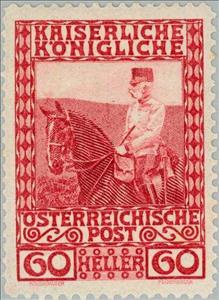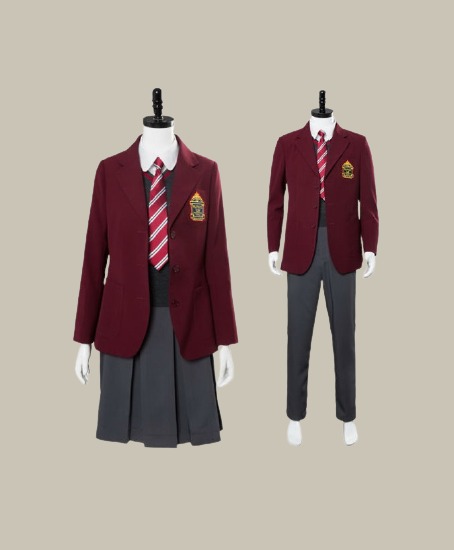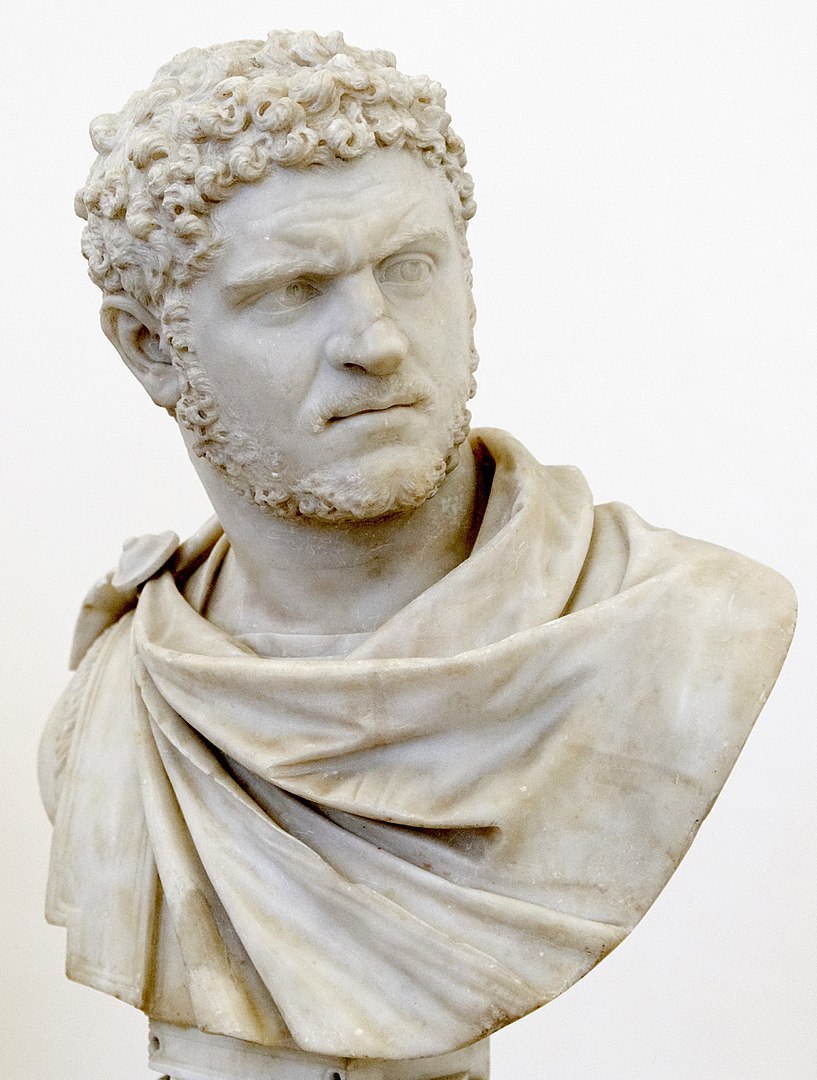Stamp: Emperor Franz Joseph on horse (Austria 1908)
Emperor Franz Joseph on horse (Austria 1908)
01 January (Austria ) within release Jubilee goes into circulation Stamp Emperor Franz Joseph on horse face value 60 Austro-Hungarian heller
| Stamp Emperor Franz Joseph on horse in catalogues | |
|---|---|
| Michel: | Mi:AT 151w |
| Stamp Number: | Sn:AT 122 |
| Yvert et Tellier: | Yt:AT 113 |
Stamp is vertical format.
w = white to yellowish printing paperAlso in the issue Jubilee:
- Stamp - Emperor Charles VI (1711-40) face value 1;
- Stamp - Empress Maria Theresia (1740-80) by Martin von Meytens face value 2;
- Stamp - Emperor Joseph II (1780-90) by Adam Jakob face value 3;
- Stamp - Emporer Joseph II (1780-90) by Adam Jakob face value 3;
- Stamp - Emperor Franz Joseph (1848-1916) face value 5;
- Stamp - Emporer Franz Joseph (1848-1916) face value 5;
- Stamp - Emporer Leopold II (1790-92) face value 6;
- Stamp - Emperor Franz Joseph (1848-1916) face value 10;
- Stamp - Emporer Franz Joseph (1848-1916) face value 10;
- Stamp - Emporer Franz I (1792-1835) face value 12;
- Stamp - Emperor Ferdinand I (1835-48) face value 20;
- Stamp - Emporer Franz Joseph (1848-1916) face value 25;
- Stamp - Emporer Franz Joseph in 1848 face value 30;
- Stamp - Emporer Franz Joseph in 1878 face value 35;
- Stamp - Emperor Franz Joseph in marshal uniform face value 50;
- Stamp - Emperor Franz Joseph on horse face value 60;
- Stamp - Emperor Franz Joseph in coronation vestment face value 1;
- Stamp - Schönbrunn Palace face value 2;
- Stamp - Vienna Hofburg face value 5;
- Stamp - Emperor Franz Joseph (reign 1848-1916) face value 10;
- Stamp - Vienna Hofburg face value 5;
- Stamp - Schönbrunn Palace face value 2;
- Stamp - Emperor Franz Joseph on horse face value 60;
- Stamp - Emperor Franz Joseph in 1878 face value 35;
- Stamp - Emperor Franz Joseph in coronation vestment face value 2*1;
- Stamp - Emperor Franz Joseph in marshal uniform face value 50;
- Tete-Beche - Emperor Franz Joseph (1848-1916) face value 2*5;
- Stamp - Emperor Leopold II (1790-92) face value 6;
Stamp Emperor Franz Joseph on horse it reflects the thematic directions:
A head of state (or chief of state) is the public persona that officially represents the national unity and legitimacy of a sovereign state. In some countries, the head of state is a ceremonial figurehead with limited or no executive power, while in others, the head of state is also the head of government. In countries with parliamentary governments, the head of state is typically a ceremonial figurehead that does not actually guide day-to-day government activities and may not be empowered to exercise any kind of secular political authority (e.g., Queen Elizabeth II as Head of the Commonwealth). In countries where the head of state is also the head of government, the president serves as both a public figurehead and the actual highest ranking political leader who oversees the executive branch (e.g., the President of the United States).
Mammals are any vertebrates within the class Mammalia (/məˈmeɪli.ə/ from Latin mamma "breast"), a clade of endothermic amniotes distinguished from reptiles (including birds) by the possession of a neocortex (a region of the brain), hair, three middle ear bones and mammary glands. All female mammals nurse their young with milk, secreted from the mammary glands. Mammals include the largest animals on the planet, the great whales. The basic body type is a terrestrial quadruped, but some mammals are adapted for life at sea, in the air, in trees, underground or on two legs. The largest group of mammals, the placentals, have a placenta, which enables the feeding of the fetus during gestation. Mammals range in size from the 30–40 mm (1.2–1.6 in) bumblebee bat to the 30-meter (98 ft) blue whale. With the exception of the five species of monotreme (egg-laying mammals), all modern mammals give birth to live young. Most mammals, including the six most species-rich orders, belong to the placental group. The largest orders are the rodents, bats and Soricomorpha (shrews and allies). The next three biggest orders, depending on the biological classification scheme used, are the Primates (apes and monkeys), the Cetartiodactyla (whales and even-toed ungulates), and the Carnivora (cats, dogs, seals, and allies).
A uniform is a variety of costume worn by members of an organization while usually participating in that organization's activity. Modern uniforms are most often worn by armed forces and paramilitary organizations such as police, emergency services, security guards, in some workplaces and schools, and by inmates in prisons. In some countries, some other officials also wear uniforms in their duties; such is the case of the Commissioned Corps of the United States Public Health Service or the French prefects. For some organizations, such as police, it may be illegal for non-members to wear the uniform.
The horse (Equus ferus caballus) is one of two extant subspecies of Equus ferus. It is an odd-toed ungulate mammal belonging to the taxonomic family Equidae. The horse has evolved over the past 45 to 55 million years from a small multi-toed creature, Eohippus, into the large, single-toed animal of today. Humans began to domesticate horses around 4000 BC, and their domestication is believed to have been widespread by 3000 BC. Horses in the subspecies caballus are domesticated, although some domesticated populations live in the wild as feral horses. These feral populations are not true wild horses, as this term is used to describe horses that have never been domesticated, such as the endangered Przewalski's horse, a separate subspecies, and the only remaining true wild horse. There is an extensive, specialized vocabulary used to describe equine-related concepts, covering everything from anatomy to life stages, size, colors, markings, breeds, locomotion, and behavior.
The word emperor (from Latin: imperator, via Old French: empereor) can mean the male ruler of an empire. Empress, the female equivalent, may indicate an emperor's wife (empress consort), mother/grandmother (empress dowager/grand empress dowager), or a woman who rules in her own right and name (empress regnant or suo jure). Emperors are generally recognized to be of the highest monarchic honour and rank, surpassing king. In Europe, the title of Emperor has been used since the Middle Ages, considered in those times equal or almost equal in dignity to that of Pope due to the latter's position as visible head of the Church and spiritual leader of the Catholic part of Western Europe. The emperor of Japan is the only currently reigning monarch whose title is translated into English as "Emperor"
Animals are multicellular, eukaryotic organisms of the kingdom Animalia (also called Metazoa). All animals are motile, meaning they can move spontaneously and independently, at some point in their lives. Their body plan eventually becomes fixed as they develop, although some undergo a process of metamorphosis later on in their lives. All animals are heterotrophs: they must ingest other organisms or their products for sustenance.






